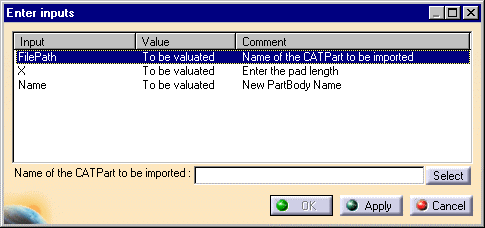 |
-
In the Product Knowledge Template workbench, click the
 icon. The Knowledgeware Script Editor is displayed.
icon. The Knowledgeware Script Editor is displayed.
-
Enter the script below
import Input : FilePath "Name of the CATPart to be imported";
Pad1 isa CATPart
{
mypad isa Part
{
X = 10mm, Input : Length "Enter the pad length";
PartBody, Input:Name "New PartBody Name" isa BodyFeature
{
S isa Sketch.1{}
P isa Pad("S"){}
}
}
}
|
-
Click Generate. The dialog box below is
displayed:

-
To enter the FilePath input, click Select then
select the
PktSketchToImport.CATPart sample. Click Apply.
-
The X value is now highlighted in the dialog box and you
are prompted to enter the X value, that is the pad length. To use the
default value, click Apply. Otherwise, enter a new value in
the X field, then click Apply.
-
If need be, repeat this operation for the Name input.
Click Apply to enter the Name value. OK must now be active. (OK
is grayed out if there is still one or more inputs to be specified).
Click OK. The extruded pad is generated.
|
![]()
![]()
![]()